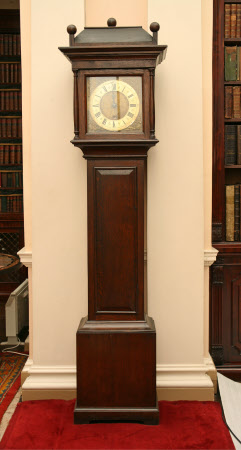Harrison Clock
John Harrison
Category
Horology
Date
1717
Materials
Pine, boxwood, oak, steel, brass
Measurements
2290 x 570 x 330 mm
Place of origin
England
Order this imageCollection
Nostell Priory, West Yorkshire
NT 959830
Caption
John Harrison was born at Nostell, the son of the estate carpenter. The movement of this rare, early clock is made of wood. There are only three known to survive from this time, this is the latest, created in 1717. John Harrison famously went on to solve the ‘longitude problem’, saving the lives of many seafarers.
Summary
8 day hour-striking longcase clock in oak case by John Harrison, Barrow, c.1717 . Oak posted frame construction movement with anchor escapement, wood rod pendulum and count-wheel hour striking on a bell. The wheels are of oak with segments of oak teeth sectioned into the rim of the wheels. The oak barrels have oak wheels attached at one end which are driven by a pinion on a winding key, inserted through apertures revealed on removing the two lower spandrels on the dial. The pinions in the movement are cut from solid boxwood and have steel pivots inserted in each end, which run in brass bushes in the oak frame. The original oak pulleys have steel arbors with steel pivots running in steel bearings in the steel stirrup of each pulley. The weights are of lead. The oak dial has a painted gilt centre, with brass cherub and crown spandrels and an engraved brass chapter ring signed: John Harrison, Barrow at VI o’clock. A square calendar aperture shows the date, inscribed in ink on a paper covered disc, signed under the dial Jn Harrison 1717. The oak case has a caddy top hood with three wooden finials. There is a rectangular trunk door and rectangular base with skirting. Note: The case is a later, probably 19th century replacement, as is the wooden rod pendulum.
Full description
John Harrison (1693-1776) was born at Foulby, part of the Nostell estate. His grandfather was Parish Clerk and his father, Henry Harrison, was a skilled carpenter who is thought to have worked for Sir Rowland Winn, 3rd baronet (1675-1721). In 1699 the family moved to Barrow-upon-Humber, immediately next to the Thornton Curtis estate also owned by the Winns. It is unclear if this move was through Winn family patronage or personal connection, but Harrison's appointment as Parish Clerk in Barrow soon after suggests he was already well-connected upon arrival. Two of Harrison's sons, John and James went on to work as clockmakers, with John famously solving the 'longtitude problem'. This clock is the third of only three to survive from John Harrison's early horological output and has a provenance from the Barrow/Appleby area. It is likely to have been acquired by the Winn family in the late 1890s/early 1900s specifically because they wanted to celebrate the connection between the celebrated Harrison and the Nostell estate (see also NT 960079 for an Angelica Kauffman self-portrait acquired around the same time for similar reasons). Part of the door for the original case with a sunrise/sunset and equation table written in Harrison's hand is now in the collection of the Clockmakers Society (Science Museum).
Provenance
Believed to have been owned by Mary Marris of Winterton and later Roxby, North Lincolnshire (both close to Barrow-upon-Humber) and purchased by Rev.John Cross (1821-1897), Vicar of Appleby, North Lincolnshire after her death in 1872 (for Cross' ownership, see 'The Church Bells of the County & City of Lincoln, Thomas North 1882 p61). The Winn family of Nostell owned an estate at Appleby and Rowland Winn, 1st Baron St Oswald (1820-1893) had appointed Cross to the living in 1849 and was a political colleague of his younger brother, Richard Assheton Cross M.P. (later Viscount Cross). Probably acquired by Rowland, 2nd Baron St Oswald after Cross' death in 1897, possibly as a gift from Cross' widow. Passed by inheritance to 4th Lord St Oswald (1916-1984), transferred with other Nostell chattels to the National Trust via Acceptance in Lieu in 1986.
Makers and roles
John Harrison, horologist
